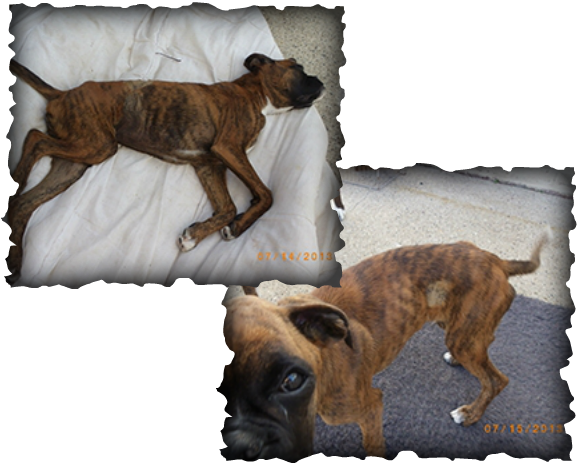Symptoms of Boxer JKD
|
Early Symptoms include:
|
Early diagnosis of Boxer JKD can easily be missed, as frequent urination and excessive water consumption is often mistaken for the normal behaviour of active Boxer puppies. It is often the onset of more severe symptoms that will be the first signs that something is wrong with the dog.
If this is your first puppy, it can be difficult to know how much a normal Boxer drinks. It is abnormal if a dog drinks more than 100ml per kg per 24hrs on a regular basis. So, drinking more than 1 liter per 10kg dog in 24 hours on a regular basis is excessive. Water intake is dependent on temperature and activity level, so drinking more than that on a hot day is perfectly normal. The best way to find out if the dog's water intake is normal or excessive is to measure all the water the dog drinks and gets through food during a three day period, then calculate the average intake of water per day based on those measurements.
Excessive urination can be seen as too much urine produced as a result of drinking too much, but sometimes the frequency of urination is the only sign that the owner notices. The excessive urine production may lead to difficulty in house training the puppy.
Diagnosis
If your boxer has any of these symptoms, or has a sibling that has been diagnosed with JKD, you should see your veterinarian.
The veterinarians work up will consist of urinalysis, blood-work and preferably diagnostic imaging to see how the kidneys look – in shape, size and structure.
The diagnosis is based on these tests as well as a thorough history and ruling out other diseases that can mimic Boxer JKD, which diseases this can be will vary depending on where you live.
Read more under "Diagnosis of Boxer JKD"
If this is your first puppy, it can be difficult to know how much a normal Boxer drinks. It is abnormal if a dog drinks more than 100ml per kg per 24hrs on a regular basis. So, drinking more than 1 liter per 10kg dog in 24 hours on a regular basis is excessive. Water intake is dependent on temperature and activity level, so drinking more than that on a hot day is perfectly normal. The best way to find out if the dog's water intake is normal or excessive is to measure all the water the dog drinks and gets through food during a three day period, then calculate the average intake of water per day based on those measurements.
Excessive urination can be seen as too much urine produced as a result of drinking too much, but sometimes the frequency of urination is the only sign that the owner notices. The excessive urine production may lead to difficulty in house training the puppy.
Diagnosis
If your boxer has any of these symptoms, or has a sibling that has been diagnosed with JKD, you should see your veterinarian.
The veterinarians work up will consist of urinalysis, blood-work and preferably diagnostic imaging to see how the kidneys look – in shape, size and structure.
The diagnosis is based on these tests as well as a thorough history and ruling out other diseases that can mimic Boxer JKD, which diseases this can be will vary depending on where you live.
Read more under "Diagnosis of Boxer JKD"



